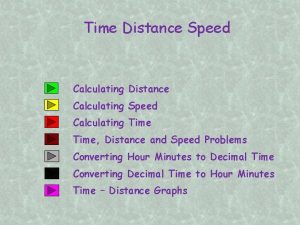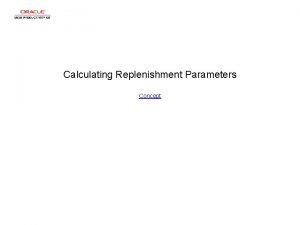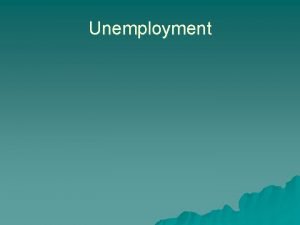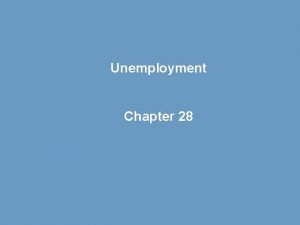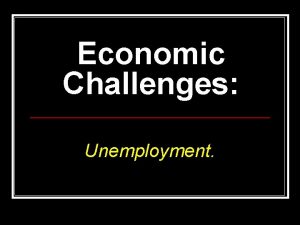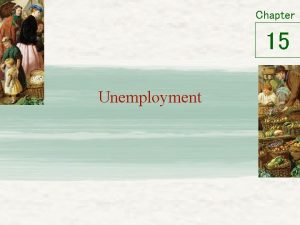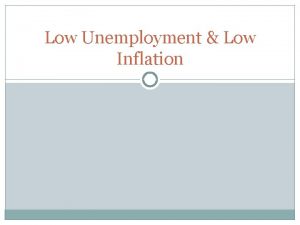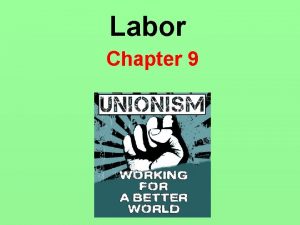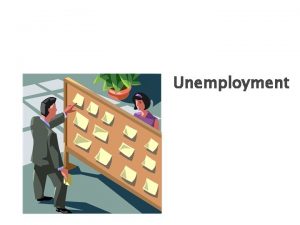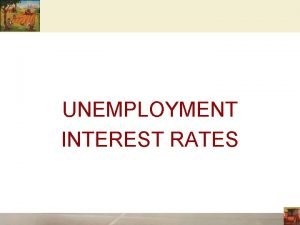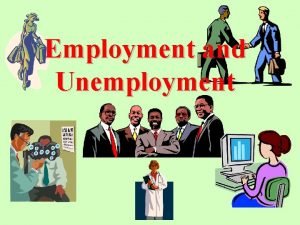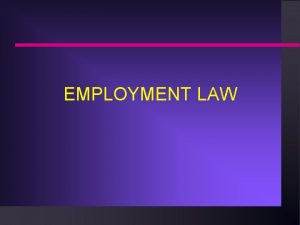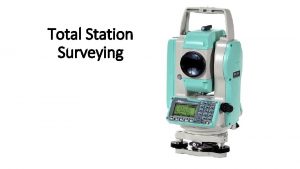Employment Unemployment Calculating Unemployment Start with the total































- Slides: 31

Employment & Unemployment

Calculating Unemployment Start with the total population of the US: • Subtract those under 16 • Subtract those in the Armed Forces and "institutionalized"

Calculating Unemployment This leaves you with the "Non-Institutional Adult Civilians": • Subtract those already retired and the “homemakers” • Subtract full time students over the age of 16 if not looking for work • Subtract the "discouraged" (those not looking)

Calculating Unemployment This leave you with the "Civilian Labor Force": This includes: • Employed: Full Time or Part Time, counted during the week of the 12 th of the month. • Employed: unpaid workers in family businesses, if working over 15 hours in that business. • Those on sick leave, on strike, or on vacation during the week of the 12 th of the month.

Calculating Unemployment • Unemployed because they are actively looking for work but can't find work, are waiting for better careers, or seasonal changes.


Civilian Employment 1960 to 2000 Year Civilian Labor Force Civilian Noninstitutional Population Labor Force Aged 16 and over Employed Unemployed 1960 117 66 4 1970 137 79 4 1980 168 99 8 1990 188 117 7 2000 209 135 6 Total Unemployment Rate (UR) Labor Force Participation Rate (LFPR)

Civilian Employment 1960 to 2000 Year Civilian Labor Force Civilian Noninstitutional Population Labor Force Aged 16 and over Employed Unemployed Total 1960 117 66 4 70 1970 137 79 4 83 1980 168 99 8 107 1990 188 117 7 124 2000 209 135 6 141 Unemployment Rate (UR) Labor Force Participation Rate (LFPR)

Civilian Employment 1960 to 2000 Year Civilian Labor Force Unemployment Rate (UR) Civilian Noninstitutional Population Labor Force Aged 16 and over Employed Unemployed Total 1960 117 66 4 70 5. 7% 1970 137 79 4 83 4. 8% 1980 168 99 8 107 7. 5% 1990 188 117 7 124 5. 6% 2000 209 135 6 141 4. 3% Labor Force Participation Rate (LFPR)

Civilian Employment 1960 to 2000 Year Civilian Labor Force Unemployment Rate (UR) Labor Force Participation Rate (LFPR) 70 5. 7% 60% 4 83 4. 8% 61% 99 8 107 7. 5% 64% 188 117 7 124 5. 6% 66% 209 135 6 141 4. 3% 67% Civilian Noninstitutional Population Labor Force Aged 16 and over Employed Unemployed Total 1960 117 66 4 1970 137 79 1980 168 1990 2000

1. In which year was the economy very close to full employment as indicated in the Humphrey Hawkins Act? 2000. The unemployment rate was the lowest in that year. 2. Why has the labor force participation rate increased since the 1960 s? More women and retirees have entered or re-entered the labor force. 3. Do the data on the national unemployment rate in Figure 11. 1 reflect the extent of unemployment among a particular group in our society, such as teenagers aged 16 to 19? Explain. No, the data are too aggregated. The data does not provide information for different demographic groups

Types of Unemployment

Four Kinds of Unemployment Frictional Unemployment: Between jobs by personal choice

Four Kinds of Unemployment Seasonal Unemployment: Job depends on season or weather

Four Kinds of Unemployment Structural Unemployment: Lost jobs due to technology or qualification changes


Four Kinds of Unemployment Cyclical Unemployment: Lost jobs due to recessions or a downturn in the economy

Types of Unemployment Worksheet

1) A nurse was not satisfied with her job in a hospital so she left the job to find a new job in a health clinic. Frictional 2) A factory lays workers off from producing CDs due to demand changes to MP 3 systems. Structural

3) Every winter, brick layers in the north have no work. Seasonal 4) Since graduating from law school, a woman waits to interview several firms before selecting a new job. Frictional

5) An apple picker only finds work during the harvest season. Seasonal 6) The discovery of crude oil puts whalers in the Northeast out of work. Structural

7) Reductions in tax revenues during a recession cause layoffs of teachers. Cyclical 8) In the US, jobs are shifted to Mexico to seek lower worker wages. Structural

9) A worker quits a job to stay and help an ailing parent. Discouraged or Not Counted 10) People who drop out of school or fail to acquire the minimum skills needed for the current job market. Frictional

Full Employment • Full employment means no cyclical unemployment. Also called the natural rate of unemployment. • NOT zero unemployment, as frictional and structural unemployment are regarded as unavoidable.

Benchmarks of Unemployment 0 to 3% Overextended economy, war 4 to 5% 6+% 25% economy “Full Employment” Unemployment Rate (Efficient) “Weak” Economy or “Recession” Economy Highest official unemployment rate in 1933

Underemployed Individuals who are either working part-time and seeking full-time employment, or are employed at jobs below their capacity.


Underemployed individuals are counted as being employed and not included in the unemployment rate. *For-Profit-Colleges commonly misreported or have been misleading in reporting employment statistics after graduation

How does the Bureau of Labor Statistics Classify these People? ü Labor Force Employed ü Labor Force Unemployed ü Not part of the Labor Force

Labor Force Employed 1. A high school senior who has a part time job every afternoon. 2. A high school senior who goes to school but works 40 hours a week. 3. A marine, paid to be a soldier by the Department of Defense, stationed in Afghanistan. 4. A retired woman, receiving a pension, living in a nursing home 5. A full time college student (15 “hours” of classes), working 20 hours a week 6. A retired military sergeant, now working as a teacher 7. A live at home mom, earning extra money providing day-care services to 2 other families 8. A “street pharmacist” earning 50 K a year providing “private” medicines 9. A public school teacher, not paying into Social Security because the state has a separate retirement system 10 The husband in a small restaurant who runs the store but his wife “owns” the place because she is the lead chef Labor Force Unemployed Not part of the Labor Force X X X X X

11. A worker at Wal-Mart who is forbidden by the company from working more than 35 hours because Wal -Mart doesn’t pay for insurance X 12. A teacher who just had a baby, is taking leave without pay because she used up her annual “sick” days X X 13. A steel mill worker refusing to work due to a union wage strike X 14. An auto worker, laid-off by Toyota during the winter due to slow sales 15. A worker who got fired, is suing the company, and will not apply for another job until the suit is settled 16. A Ph. D in Physics, laid-off from his very high paying job at NASA, and is now greeting people at Wal-Mart for 15 hours a week; the only job available 17. A teacher during July and August, when school is out. 18. The adult child of restaurant owners who helps at the store but is only “paid” with room and board, not a salary 19. A factory worker, out of work for over 2 years but still looking for a job that pays as well as the old one 20. A factory worker, out of work for over 2 years and living only on unemployment benefits from the labor union funds. X X X
 Calculate inflation rate
Calculate inflation rate Care of compound microscope
Care of compound microscope Calculate total magnification
Calculate total magnification But we gotta start somewhere
But we gotta start somewhere Jumpstart triage age
Jumpstart triage age Total revenues minus total costs equals
Total revenues minus total costs equals Total revenues minus total costs equals
Total revenues minus total costs equals Ciclo de servicio de una aerolinea
Ciclo de servicio de una aerolinea Total revenue minus total expenses
Total revenue minus total expenses Total revenues minus total costs equals
Total revenues minus total costs equals Cái miệng bé xinh thế chỉ nói điều hay thôi
Cái miệng bé xinh thế chỉ nói điều hay thôi Hình ảnh bộ gõ cơ thể búng tay
Hình ảnh bộ gõ cơ thể búng tay đặc điểm cơ thể của người tối cổ
đặc điểm cơ thể của người tối cổ Mật thư anh em như thể tay chân
Mật thư anh em như thể tay chân Tư thế worm breton
Tư thế worm breton ưu thế lai là gì
ưu thế lai là gì Tư thế ngồi viết
Tư thế ngồi viết Chó sói
Chó sói Thẻ vin
Thẻ vin Thơ thất ngôn tứ tuyệt đường luật
Thơ thất ngôn tứ tuyệt đường luật Các châu lục và đại dương trên thế giới
Các châu lục và đại dương trên thế giới Từ ngữ thể hiện lòng nhân hậu
Từ ngữ thể hiện lòng nhân hậu Diễn thế sinh thái là
Diễn thế sinh thái là Thứ tự các dấu thăng giáng ở hóa biểu
Thứ tự các dấu thăng giáng ở hóa biểu 101012 bằng
101012 bằng Alleluia hat len nguoi oi
Alleluia hat len nguoi oi Lời thề hippocrates
Lời thề hippocrates Hổ sinh sản vào mùa nào
Hổ sinh sản vào mùa nào đại từ thay thế
đại từ thay thế Vẽ hình chiếu vuông góc của vật thể sau
Vẽ hình chiếu vuông góc của vật thể sau Quá trình desamine hóa có thể tạo ra
Quá trình desamine hóa có thể tạo ra































